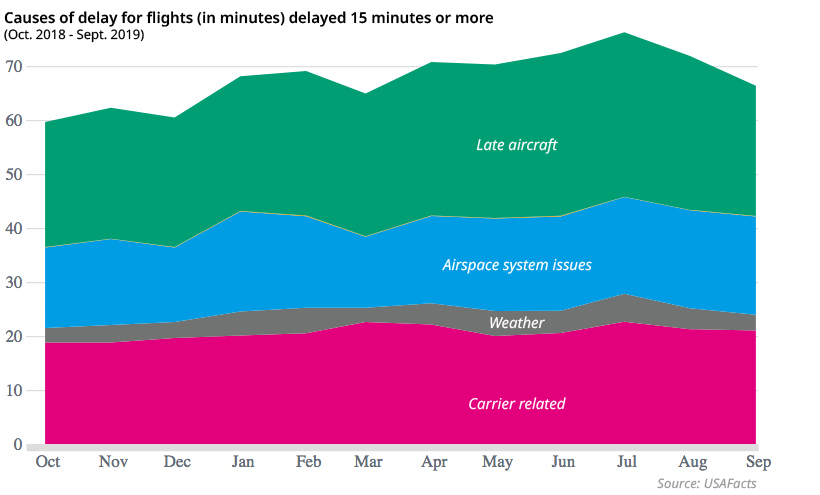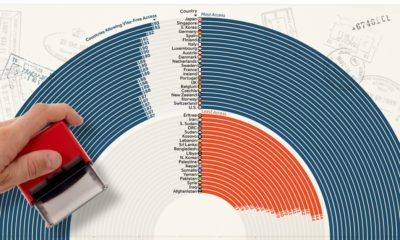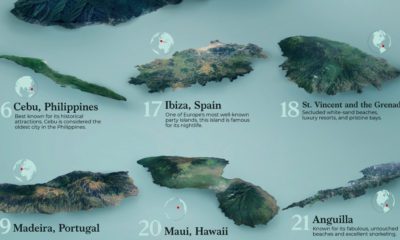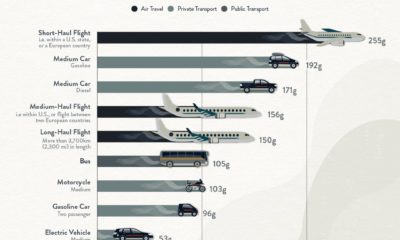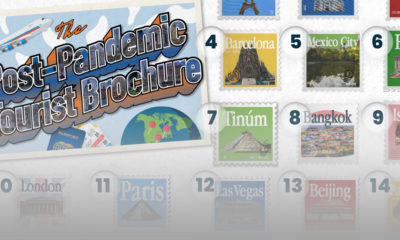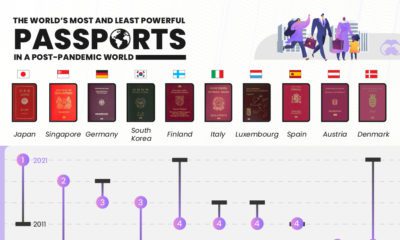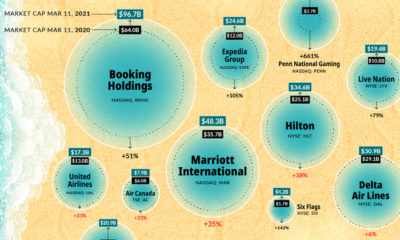With frequent flights comes frequent problems. Unexpected travel irritations, delays, and cancellations are all common issues faced by flyers the world over. Correspondingly, certain airports have developed a reputation for making their passengers wait. Today’s interactive chart from USAFacts shows the percentage of flights delayed, as well as the average length of those delays, at U.S. airports between October 2018 and September 2019.
The Top 10 Airports With the Longest Delays
In the worst airports across the country, over 25% of all flights get delayed. Here is a list of the top offenders based on percentage of flights delayed and the average delay, according to flight data. Newark Liberty International takes the top spot, with 26.5% of all flights taking off late. To make matters worse, it also had the longest average delay time, at 22 minutes per flight. The runner-up is another New York-based airport, LaGuardia, averaging close to 20 minutes per flight delay. The third worst offender was Chicago O’Hare International airport, where over a quarter of flights arrived late, with an average delay of 19 minutes. Chicago O’Hare International saw more flights than Newark and LaGuardia combined, making average delays more costly.
What’s Behind These Major Flight Delays?
While the New York area hosts two of the worst airports in the country, flight delays are exacerbated by a number of regional factors. First, it hosts one of the busiest air corridors worldwide. As a result, any unexpected interruption or delay has an outsized effect on flights arriving at their destination on time. Coupled with this is the commanding presence of United Airlines. As one of the largest airlines in the world, it operates over 401 daily flights at Newark airport. Additionally, United has been known to have operational issues. For example, in June 2019, significant aircraft problems led the Newark airport to suspend flights altogether. There are four major causes of flight delays: poor weather conditions, late aircraft, carrier related (such as baggage, fueling, or maintenance problems), and airspace system issues.
According to this data, it’s clear that late aircraft is the most prevalent cause for flight delays that ended up being longer than 15 minutes. Late aircraft creates a domino effect: when an airplane arrives late at an airport, a following flight that uses the same aircraft will depart behind schedule. In peak months such as July, this contributes to nearly 50% of flight delays.
Worst Months of the Year to Fly
The number of flights on U.S. airlines has more than tripled, from 275 million flights in 1978 to 889 million in 2018. Along with this, flight activity is typically highest in the summer—coinciding with July’s highest average flight delay of 76 minutes. Months in the summer followed suit, with June averaging 72 minutes per delay and August having an average delay of 71 minutes, among flights that were delayed over 15 minutes. Perhaps surprisingly, flights in December bucked this trend. Even as a flight-heavy month, average long delays hovered around 60 minutes during the holiday season.
The 10 U.S. Airports with the Fewest Delays
By comparison, a number of airports appear to have avoided this trap. Data below shows the top airports in the U.S. with the fewest flight delays during the same time period. As the volume of air travel continues to climb, it is clear that some airports underperform others by a wide margin. To break the vicious cycle of delays, it will be vital for airports to get initial flights departing on time in the first place. on Even while political regimes across these countries have changed over time, they’ve largely followed a few different types of governance. Today, every country can ultimately be classified into just nine broad forms of government systems. This map by Truman Du uses information from Wikipedia to map the government systems that rule the world today.
Countries By Type of Government
It’s important to note that this map charts government systems according to each country’s legal framework. Many countries have constitutions stating their de jure or legally recognized system of government, but their de facto or realized form of governance may be quite different. Here is a list of the stated government system of UN member states and observers as of January 2023: Let’s take a closer look at some of these systems.
Monarchies
Brought back into the spotlight after the death of Queen Elizabeth II of England in September 2022, this form of government has a single ruler. They carry titles from king and queen to sultan or emperor, and their government systems can be further divided into three modern types: constitutional, semi-constitutional, and absolute. A constitutional monarchy sees the monarch act as head of state within the parameters of a constitution, giving them little to no real power. For example, King Charles III is the head of 15 Commonwealth nations including Canada and Australia. However, each has their own head of government. On the other hand, a semi-constitutional monarchy lets the monarch or ruling royal family retain substantial political powers, as is the case in Jordan and Morocco. However, their monarchs still rule the country according to a democratic constitution and in concert with other institutions. Finally, an absolute monarchy is most like the monarchies of old, where the ruler has full power over governance, with modern examples including Saudi Arabia and Vatican City.
Republics
Unlike monarchies, the people hold the power in a republic government system, directly electing representatives to form government. Again, there are multiple types of modern republic governments: presidential, semi-presidential, and parliamentary. The presidential republic could be considered a direct progression from monarchies. This system has a strong and independent chief executive with extensive powers when it comes to domestic affairs and foreign policy. An example of this is the United States, where the President is both the head of state and the head of government. In a semi-presidential republic, the president is the head of state and has some executive powers that are independent of the legislature. However, the prime minister (or chancellor or equivalent title) is the head of government, responsible to the legislature along with the cabinet. Russia is a classic example of this type of government. The last type of republic system is parliamentary. In this system, the president is a figurehead, while the head of government holds real power and is validated by and accountable to the parliament. This type of system can be seen in Germany, Italy, and India and is akin to constitutional monarchies. It’s also important to point out that some parliamentary republic systems operate slightly differently. For example in South Africa, the president is both the head of state and government, but is elected directly by the legislature. This leaves them (and their ministries) potentially subject to parliamentary confidence.
One-Party State
Many of the systems above involve multiple political parties vying to rule and govern their respective countries. In a one-party state, also called a single-party state or single-party system, only one political party has the right to form government. All other political parties are either outlawed or only allowed limited participation in elections. In this system, a country’s head of state and head of government can be executive or ceremonial but political power is constitutionally linked to a single political movement. China is the most well-known example of this government system, with the General Secretary of the Communist Party of China ruling as the de facto leader since 1989.
Provisional
The final form of government is a provisional government formed as an interim or transitional government. In this system, an emergency governmental body is created to manage political transitions after the collapse of a government, or when a new state is formed. Often these evolve into fully constitutionalized systems, but sometimes they hold power for longer than expected. Some examples of countries that are considered provisional include Libya, Burkina Faso, and Chad.
